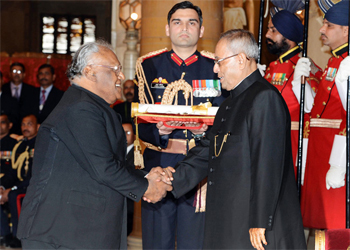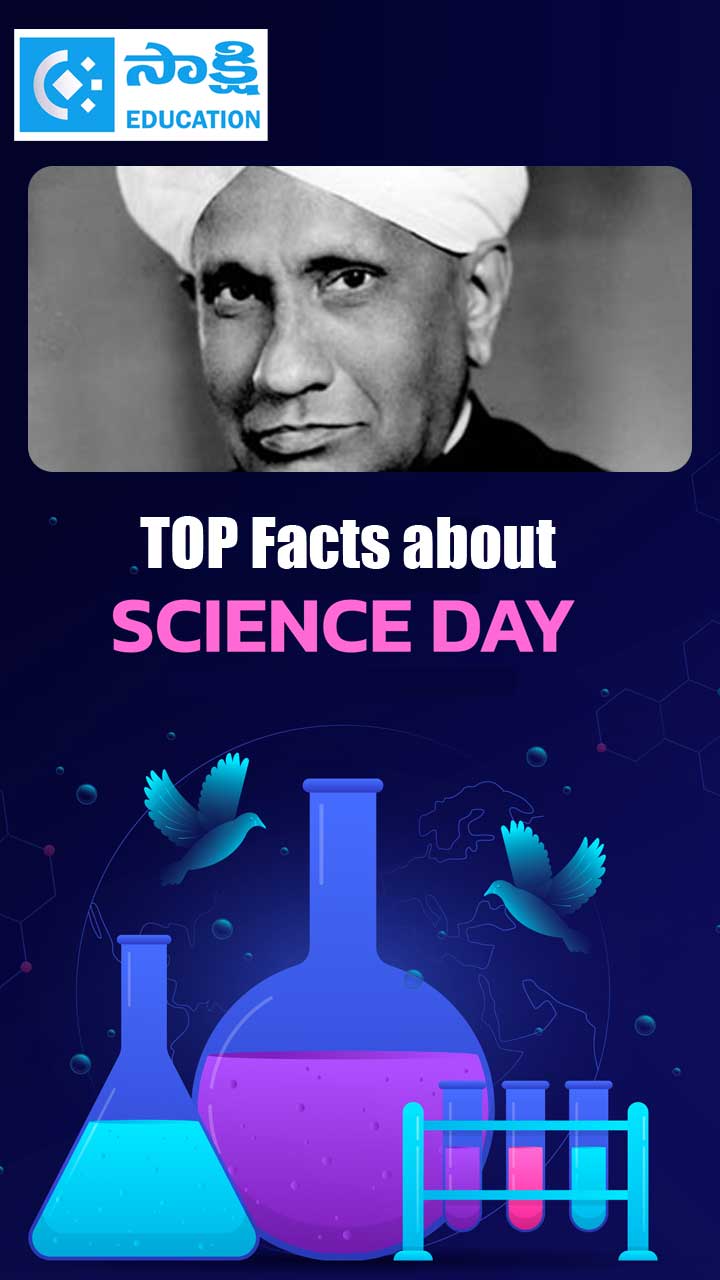Interview with Bharatharatna Dr. C.N.R.Rao
Sakshi Education

Chintamani Nagesha Ramachandra Rao known as Dr. C.N.R.Rao, a great scientist in the field of chemistry, born in a middle class family has reached great heights, served country at various positions and achieved many laurels across the globe. His contribution to the Indian Research field is unscalable, he has inspired many researchers with his indomitable dedication and will to uplift the research standards in India. He played an instrumental role in uplifting the research standards and facilities in India during his tenure as a scientific advisor to SAC-PM. He was felicitated with the highest order award “BHARATH RATNA” by the Government of India in the year 2014.
What is the reason that made you to get in to field of science?
I decided to do science in the year 1951 just after finishing my B.Sc at the age of 17. I had been inspired by Prof. C.V. Raman when I was a school student in Bangalore (in 1945).
During my M.Sc studies, I learnt about Linus Pauling and read his famous book, Nature of the Chemical Bond. That book revolutionized chemistry. It became clear to me that I had to do research of the kind described in the book by Linus Pauling.
Of various spectrums of branches in science, why have you picked up chemistry subject?
Chemistry deals with molecules and materials. The world is full of molecules and materials. I thought that I should try to understand the secret of the structure of molecules and materials in terms of the way atoms are bound together and see how the structure influences properties.
What are the difficulties in your path of research?
 When India got freedom, I had just entered college. We were very poor and there was no money or foreign exchange. Everything was available only in limited quantity. Even when I started my research career, after I came back from United States in 1959, there were no facilities worth mentioning.
When India got freedom, I had just entered college. We were very poor and there was no money or foreign exchange. Everything was available only in limited quantity. Even when I started my research career, after I came back from United States in 1959, there were no facilities worth mentioning.
In the current times, how do you see environment for research in India?
Slowly things improved. New institutions came up. Research facilities have also gradually improved and in the last 10 years, our situation is, in fact, quite good. There are a few institutions today with excellent facilities and for the first time, in the last 10-15 years, I have all the facilities required for my research. I started with nothing, but today we have almost everything. It has been a wonderful journey to see this progress in India.
Being, the scientific advisor for SAC-PM, what are the key steps you have taken?
We have (SAC-PM) recommended many things to the government and the Prime Minister about science, its administration, and funding. Many of these have been accepted and we are able to see them as actions by the government. For example, five new institutes of Indian Institutes of Science Education and Research have been established based on the recommendation of the Science Advisory Council to the Prime Minister (SAC-PM). The Ramanujan Fellowships and many such new fellowships to encourage young people were started.
The youngster’s inclination in to research has seen impulse declination, Sir could you give your opinion on this?
In the last few years, interest of young people in science has come down. It is also true that the society as a whole has looked down on science. I am told that young students who go for B.Sc in sciences are laughed at by others. This has discouraged young people. Our society should learn to respect science. Furthermore, good young scientists who do well must get good opportunities. I do not know why people discourage young people to take up science. I must say, however, in the last 2-3 years, I noticed slight improvement in the situation.
In the past you have stated that even private industries have to concentrate on research industry? Is it possible?
All most all the groups of science are supported by government today, unlike in United States or Japan. It is high time that a reasonable percentage of science expenditure comes from industry. It is only then, that we can expect full support for science reaching 2-3% of the GDP, as in many other countries.
We have to build an innovation climate India to excel in science, technology and innovation. It can expect to become a global leader only if it is able to compete with some of our neighbours.
I think that India should invest 6% of the GDP on education of which at least 2% should come to higher education. For science, it should be around 2% of the GDP which should include contribution from industry.
There was a misunderstanding about what I have said about IT. I am not against IT. We do need IT and it is important to have IT. However, what I have said is that IT should not take away all the talent. The case of Bangalore is interesting. Very few students from Bangalore come for science and such creative endeavors. This is not a good sign. It will be foolish for me to say, we should not have IT.
What would be your suggestion to our country in the fields of innovation, science and technology?
I would very much like India to do well in science, technology and innovation and become a global leader in the next 15-20 years. It should improve the education system in such a way that the young generation of the country gets good opportunities. This requires a lot of planning and we do hope that we will be able to do something in this direction. We have to create a number of outstanding institutions which can accommodate capable young people. Right now, we do not have sufficient number of outstanding institutions for brilliant young people to work in.
I enjoy reading historical novels, biographies of scientists and general fiction. I do a lot of general reading and more than that, I listen to music every day.
What is the reason that made you to get in to field of science?
I decided to do science in the year 1951 just after finishing my B.Sc at the age of 17. I had been inspired by Prof. C.V. Raman when I was a school student in Bangalore (in 1945).
During my M.Sc studies, I learnt about Linus Pauling and read his famous book, Nature of the Chemical Bond. That book revolutionized chemistry. It became clear to me that I had to do research of the kind described in the book by Linus Pauling.
Of various spectrums of branches in science, why have you picked up chemistry subject?
Chemistry deals with molecules and materials. The world is full of molecules and materials. I thought that I should try to understand the secret of the structure of molecules and materials in terms of the way atoms are bound together and see how the structure influences properties.
What are the difficulties in your path of research?
 When India got freedom, I had just entered college. We were very poor and there was no money or foreign exchange. Everything was available only in limited quantity. Even when I started my research career, after I came back from United States in 1959, there were no facilities worth mentioning.
When India got freedom, I had just entered college. We were very poor and there was no money or foreign exchange. Everything was available only in limited quantity. Even when I started my research career, after I came back from United States in 1959, there were no facilities worth mentioning.In the current times, how do you see environment for research in India?
Slowly things improved. New institutions came up. Research facilities have also gradually improved and in the last 10 years, our situation is, in fact, quite good. There are a few institutions today with excellent facilities and for the first time, in the last 10-15 years, I have all the facilities required for my research. I started with nothing, but today we have almost everything. It has been a wonderful journey to see this progress in India.
Being, the scientific advisor for SAC-PM, what are the key steps you have taken?
We have (SAC-PM) recommended many things to the government and the Prime Minister about science, its administration, and funding. Many of these have been accepted and we are able to see them as actions by the government. For example, five new institutes of Indian Institutes of Science Education and Research have been established based on the recommendation of the Science Advisory Council to the Prime Minister (SAC-PM). The Ramanujan Fellowships and many such new fellowships to encourage young people were started.
The youngster’s inclination in to research has seen impulse declination, Sir could you give your opinion on this?
In the last few years, interest of young people in science has come down. It is also true that the society as a whole has looked down on science. I am told that young students who go for B.Sc in sciences are laughed at by others. This has discouraged young people. Our society should learn to respect science. Furthermore, good young scientists who do well must get good opportunities. I do not know why people discourage young people to take up science. I must say, however, in the last 2-3 years, I noticed slight improvement in the situation.
In the past you have stated that even private industries have to concentrate on research industry? Is it possible?
All most all the groups of science are supported by government today, unlike in United States or Japan. It is high time that a reasonable percentage of science expenditure comes from industry. It is only then, that we can expect full support for science reaching 2-3% of the GDP, as in many other countries.
We have to build an innovation climate India to excel in science, technology and innovation. It can expect to become a global leader only if it is able to compete with some of our neighbours.
I think that India should invest 6% of the GDP on education of which at least 2% should come to higher education. For science, it should be around 2% of the GDP which should include contribution from industry.
There was a misunderstanding about what I have said about IT. I am not against IT. We do need IT and it is important to have IT. However, what I have said is that IT should not take away all the talent. The case of Bangalore is interesting. Very few students from Bangalore come for science and such creative endeavors. This is not a good sign. It will be foolish for me to say, we should not have IT.
What would be your suggestion to our country in the fields of innovation, science and technology?
I would very much like India to do well in science, technology and innovation and become a global leader in the next 15-20 years. It should improve the education system in such a way that the young generation of the country gets good opportunities. This requires a lot of planning and we do hope that we will be able to do something in this direction. We have to create a number of outstanding institutions which can accommodate capable young people. Right now, we do not have sufficient number of outstanding institutions for brilliant young people to work in.
I enjoy reading historical novels, biographies of scientists and general fiction. I do a lot of general reading and more than that, I listen to music every day.
Published date : 25 Oct 2014 04:10PM


















